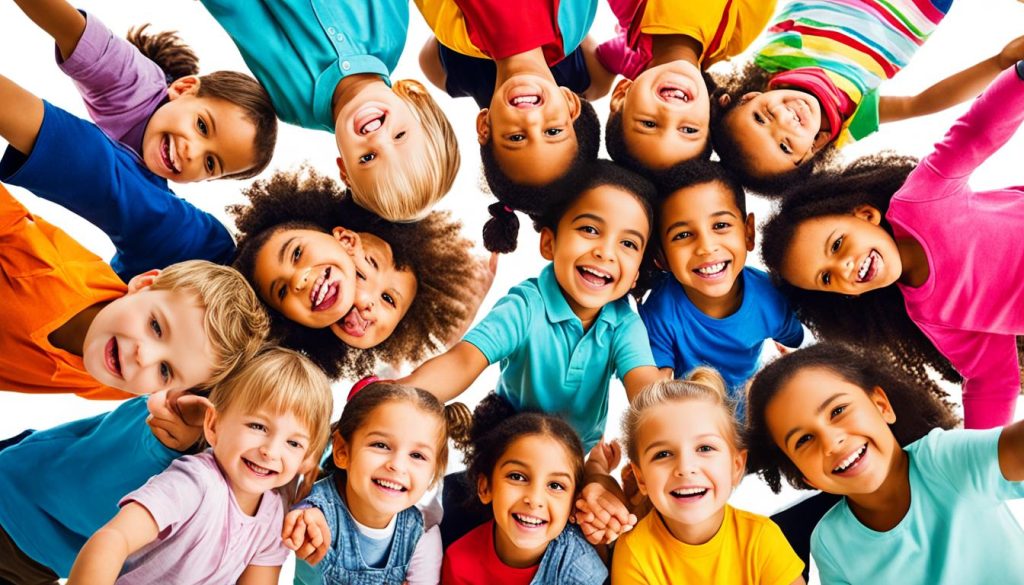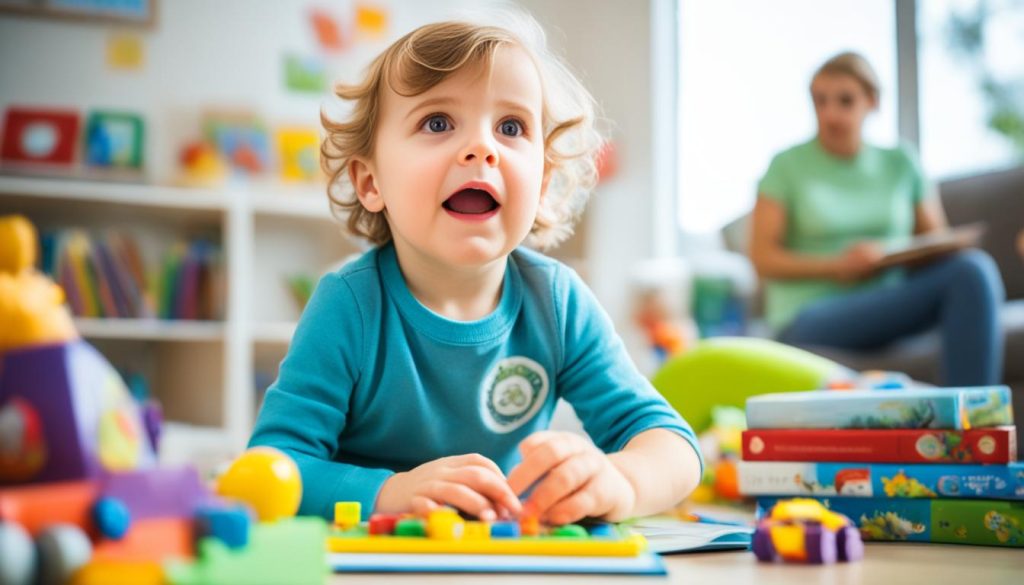Think back to when you first took your child’s hand and stepped into the world. It’s full of different faces, colors, and cultures. This is when parenting is more than just feeding and dressing your child. It’s about teaching them about diversity.
Teaching kids about differences early on is key. It helps them see the beauty of being different. Studies show that learning about social and emotional skills can boost their grades by 11 percent. This shows how important it is for kids to understand different cultures and views.
In today’s digital world, teaching kids about diversity is more important than ever. You can do this by reading diverse books, watching inclusive media, and talking openly with them. Activities that celebrate being different are also important for their learning.
It’s crucial to help kids value their own uniqueness and understand others. For more tips on this, check out this resource on understanding dynamic relationships. It talks about how knowing each child’s needs can make your family stronger.
When you teach kids about diversity and inclusion, consider using “Little Allies.” It’s a book for kids as young as five that starts important talks. Your efforts will help them grow up respecting and understanding everyone.
Key Takeaways
- Establish early awareness of differences to foster respect and inclusivity.
- Diverse books and media can effectively promote understanding in children.
- Engaging in activities that celebrate differences is crucial in teaching diversity to children.
- Investing in SEL can lead to significant academic gains and emotional intelligence growth.
- Acknowledge and embrace the uniqueness of each child to create a supportive family environment.
Understanding Diversity, Equity, and Inclusion
Learning about diversity, equity, and inclusion (DEI) is key to raising kids who are well-rounded and kind. By using DEI in everyday family talks, we teach kids about responsibility and resilience. This helps them grow into people who respect everyone and handle challenges well, like managing screen time.

What is Diversity?
Diversity means celebrating the unique qualities of each person, like race, ethnicity, gender, and more. Kids start to notice and think about gender identity early, before they turn two. By reading diverse books and talking about our differences, we teach them that everyone is special and deserves respect.
Parents should build a big library at home and share their own stories. This helps start important talks with teachers about what books to use in class. Using books by diverse authors, like those different from Dr. Seuss, can really help kids understand and appreciate diversity.
Defining Equity
Equity means making sure everyone gets the help they need to do well. This might mean special seating for physical needs or extra time for learning. Teaching kids about power helps them see how it affects others and their own place in the world.
Efforts like Educare Chicago’s use of songs and stories show how important equity is in schools. They teach kids that bad behavior doesn’t mean someone is bad at heart.
The Importance of Inclusion
Inclusion is more than just diversity; it’s making sure everyone feels welcome and valued. Educare Chicago works to make kids feel understood and respected. They show that being different is okay and that everyone has their own story to tell.
Activities like making posters about cultural heritage help kids feel proud of who they are. This builds respect for others and their differences. Families can help by reading books together, joining support groups, and being active in school committees.
For more tips on helping kids feel emotionally secure and talking about tough topics, check out how to discuss difficult topics with your child.
The Importance of Teaching Diversity at a Young Age
Teaching kids about diversity and inclusion early is key for a kinder society. It helps them see and value differences early on. This is vital for their growth and understanding of the world.

Early Awareness of Differences
By age two, kids start to see gender and racial differences. By three, they notice physical disabilities too. Being around different people and places helps them feel less confused and alone.
Learning about diversity young helps them be more empathetic. This is important for good parenting. They learn to accept everyone for who they are.
Preventing Bias Formation
Kids are easily shaped by what they learn, so teaching them about diversity early can stop biases from forming. For instance, studies show that young African American boys are more likely to be suspended or expelled. This is often due to not fitting in culturally at school.
Teaching kids to value diversity helps avoid these biases. It makes them more understanding and open-minded. This way, they can see the world from different perspectives.
Building Respectful Attitudes
Teaching kids to respect different cultures starts at home. Activities like playing diversity bingo and doing cultural art projects help a lot. Reading books like “The Sneetches” by Dr. Seuss also teaches valuable lessons.
As kids meet different people and ideas, they learn how to get along in a diverse world. This is crucial for their mental health and happiness.
Strategies for Parents to Teach Diversity and Inclusion
Talking to your kids about diversity and inclusion shapes their views and actions towards others. Regular chats with your child about these topics build empathy and understanding. Here are two ways to help your kids see everyone as equal.
Acknowledging Differences
Kids are naturally curious and spot differences easily. Instead of ignoring their questions, use them to teach. Talking openly about differences helps kids learn and feel safe to ask more.
For example, explain cultural traditions or how people look in ways kids can understand. This shows them it’s okay to notice and talk about differences. It helps stop them from judging others.
“Children with high self-esteem are more likely to be accepting of others, emphasizing the importance of building self-esteem to promote inclusivity.”
It’s also key to act inclusively yourself. Kids watch how adults behave and learn from it. If you treat everyone with respect, your kids will too. Leading by example teaches them empathy and to value everyone’s differences.

Welcoming Questions
Answering your child’s questions about diversity is important. Talking openly helps kids understand and respect differences. This kind of chat also teaches them to be respectful and well-behaved.
Every question is a chance to teach your child more. When they ask about someone different, answer with kindness and facts. This shows them it’s okay to be curious and helps manage tantrums by supporting their questions.
Using diverse books and media at home helps too. Stories with characters from different backgrounds make differences seem normal. Talking about these stories teaches your child the value of diversity and inclusion. This way, they grow up valuing and celebrating everyone’s uniqueness.
Using Books and Media to Promote Diversity
Books and media are great for teaching kids about diversity. They let kids see and understand different cultures and lifestyles. By picking the right books and media, you help your child see the world from many angles. This builds a more inclusive view and helps kids develop good habits.
Children’s Books on Diversity
Only half of children’s books feature diverse characters, showing a big gap in representation. When watching TV or reading, choose books with diverse characters and stories. Seeing themselves in stories helps kids learn and figure out who they are.
Here is a breakdown showing the representation in children’s books:
| Category | Percentage |
|---|---|
| White Characters | 50% |
| Human Characters (Preschool Media) | 42% |
| Diverse Human Characters (Preschool Media) | 14% |
Inclusive Media for Kids
Kids spend a lot of time watching screens, so media can teach them about diversity. Only 42% of preschool characters are human, and only a third are diverse. Showing diverse characters in media helps kids feel empathy and understand others better. It’s important for media to reflect the U.S. population, making kids feel proud and positive about who they are.

Discussing Characters and Scenarios
Talking about books or media with kids is key. It helps them think critically and feel empathy. Discuss the characters and stories, pointing out what’s similar and different. This talk helps kids understand and think deeply about what they watch or read.
Creating a space that values diversity lays a strong base for inclusivity. Using diverse books and media helps kids be creative and ready for a world with many cultures.
Activities to Foster Inclusivity in Children
Creating a space where kids can learn to value and respect different cultures is key. Parents can help by doing activities that show family traditions and the good things about outdoor play. They should also balance work and family life.
Experiencing Foods from Different Cultures
Trying foods from around the world can be fun and teach kids a lot. It’s a way to keep family traditions alive and help kids see the world’s diversity. Kids learn to be open to new foods and tastes, which is good for them.
A study found that 66% of parents worry about talking to their kids about differences. But 95% of kids are curious and like to try new things.
Cultural Art Projects
Doing cultural art projects lets kids get a feel for different cultures. It’s a way for parents to spend quality time with their kids and teach them about global traditions. These projects also help kids with their motor skills and creativity.
Virtual Field Trips
Virtual field trips are a great way to learn about cultures without leaving home. They offer fun and interactive ways to learn. 72% of parents think showing kids different experiences and people helps them accept differences.
By making inclusivity a part of daily life, kids grow up to be kind and respectful. They learn to see the beauty in all kinds of diversity.
Modeling Inclusive Behavior as Parents
It’s crucial for parents to model inclusive behavior to create a welcoming space for their kids. By embracing diversity and encouraging independence, you help build these values at home. Talking openly with your children is also key.
Becoming a Role Model
You, as a parent, set the example for your child. Showing them the value of positive reinforcement helps make a supportive space for all kinds of diversity. Seeing adults accept and value differences, kids are more likely to do the same.
Studies from Harvard University show that early lessons on diversity and inclusion lead to more inclusive kids. Letting kids explore different cultures through hobbies can also widen their perspectives.
Creating a Diverse Environment at Home
Exposure to diverse experiences and people normalizes differences for children. Make your home a place of diversity by using books, toys, and media that show different cultures. Taking your kids to cultural events or celebrations can deepen their understanding of diversity.
Adding financial literacy for kids in this mix helps them respect various economic backgrounds. This way, they learn to value diversity in all its forms.
Encouraging Open Conversations
Kids are naturally curious and may ask about differences when they see them. Encouraging talks about race, religion, gender, and identity creates a safe space for learning. This helps them understand the beauty of diversity.
According to the National Association for the Education of Young Children, 90% of kids ask more about diversity when parents support curiosity. These talks are vital for teaching empathy and helping kids be independent in a diverse world.
The Role of Schools in Diversity Education
Schools are key in teaching diversity. They work with teachers and parents to make a welcoming place for all students. It’s important to have a diverse curriculum and activities that celebrate different cultures.
Partnering with Educators
Working with teachers helps kids learn social skills. For example, the Bellevue School District in Washington works closely with families. They offer workshops like “Make and Take” that help parents and kids connect.
These workshops are great for getting parents involved. They prepare kids for kindergarten by showing them different cultures early on.
Inclusive Classroom Activities
Play is vital for kids, and it should be part of learning. In the Fairbanks North Star Borough School District, kids speak over 60 languages. They use diverse activities to meet the needs of all students.
These activities help kids understand and respect each other’s differences. It’s important for getting along in school and life.
Diverse Curriculum and Resources
A good education includes a wide range of subjects and materials. In the Fairbanks North Star Borough, about 10 percent are Alaska Native, and 8 percent are learning English. This shows the need for a curriculum that reflects everyone’s background.
Dr. Rebecca Bigler from the University of Texas at Austin says celebrating diversity helps kids do well. Schools use diverse books and events to show kids different ways of life. This makes learning more inclusive.
| School District | Student Demographics | Key Initiatives |
|---|---|---|
| Fairbanks North Star Borough | Speaks 60 languages, 10% Alaska Native, 8% English language learners | Parent-mentor programs, “Make and Take” workshops |
| Bellevue School District | 21% Asian, 3% African American, 8% Hispanic, 68% White | Partnering with families, inclusive classroom activities |
Schools can make a big difference by being inclusive. They help kids grow and appreciate diversity. This prepares them for kindergarten and beyond.
The Connection Between Emotional Intelligence and Inclusion
Understanding how emotional intelligence in children relates to inclusion is key. It helps create a supportive and caring environment. Emotional intelligence means knowing how to handle your own and others’ feelings. For kids, learning this early changes how they interact and connect with others.
Fostering Empathy in Kids
Empathy is a big part of emotional intelligence. Teaching kids to understand and connect with others’ feelings helps them be more inclusive. By discussing tough topics like bullying and diversity, you help them see different views and experiences. This builds their strength and helps them respect and stand up for others.
Developing Social Emotional Learning (SEL) Skills
Social Emotional Learning (SEL) skills are key for emotional intelligence in kids. They help kids deal with social situations, build strong relationships, and make good choices. Studies show that SEL programs lower stress, improve how kids see themselves and others, and boost their grades (Curr Psychol. 2021; 40:4333–47).
When kids do activities that teach SEL, they get better at setting limits and talking about hard topics. This is crucial for creating a welcoming and understanding community.
Conclusion
Teaching kids about diversity and inclusion starts at home. As parents, you can shape your children’s views on these topics. Use daily conversations, media, and experiences to teach them. This helps build a more just and understanding society for the future.
By doing this, you help your kids become resilient and emotionally strong. These skills are key for their growth. It’s a powerful way to make a difference.
Your influence is crucial in today’s digital world. With easy access to diverse content, you can teach your kids about gratitude and different cultures. Research shows 54% of parents see the value in raising kids with a focus on diversity and inclusion.
By being inclusive yourself, using diverse media, and talking openly, you’re shaping a better future. This approach is vital for a more accepting world.
Child nutrition and development are also key in this journey. Programs like Nutrition Detectives™ show how teaching kids about healthy eating can also teach them about diversity. This helps them respect different cultures.
Also, teaching your kids to understand emotions can prevent depression and emotional issues. The U.S. Department of Health and Human Services highlights family involvement in early years as crucial for these outcomes. These efforts will help you raise kids who are kind, respectful, and inclusive.
FAQ
What is Diversity?
Defining Equity
The Importance of Inclusion
Why is it crucial to teach diversity at a young age?
How can parents prevent bias formation in their children?
How do children’s books and media promote diversity?
What are some activities that foster inclusivity in children?
How can parents model inclusive behavior?
What is the role of schools in diversity education?
What is the connection between emotional intelligence and inclusion?
This post contains affiliate links. If you click on a link and make a purchase, I may earn a small commission — at no extra cost to you. Thank you for supporting this blog and helping me keep the patterns free! Read the full Affiliate Disclosure & Transparency.
